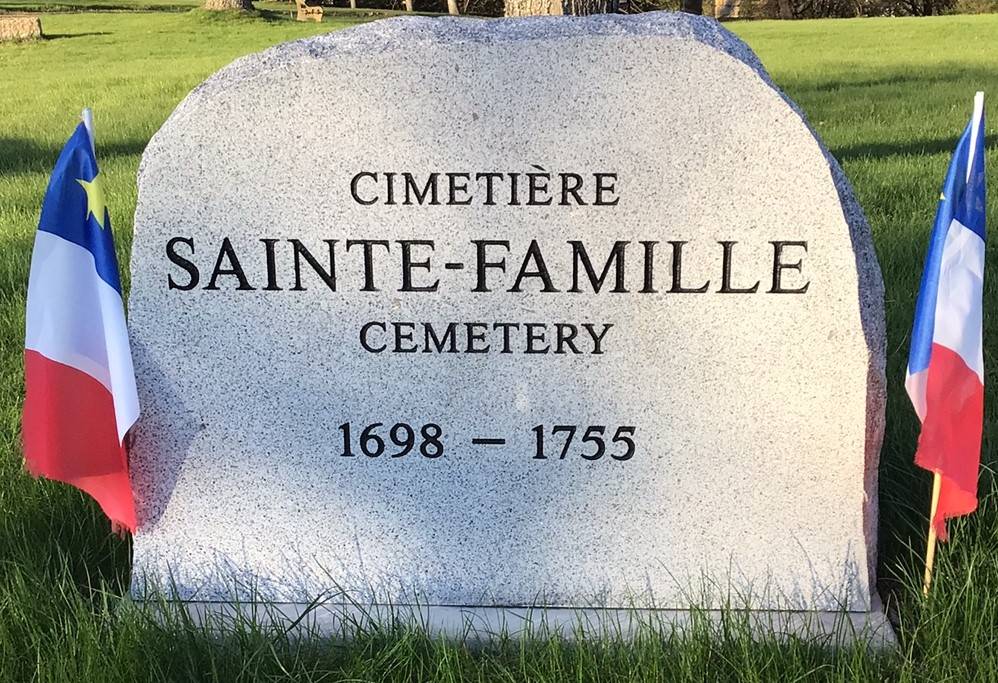PISIQUID
The Mi’kmaq occupied this region for thousands of years. Pisiquid, the old name of the region and the main river, comes from the Mi’kmaw word pisekitk which means "where the current forks." The Acadians settled on both sides of the Pisiquid River (today the Avon River).
SAINTE-FAMILLE PARISH
 Established in the 1680s, Pisiquid became one of the major settlements in the French colony of Acadie. With an economy based on farming the marshlands, which were drained and dyked, the settlement prospered in the 18th century. Founded in 1698, Sainte-Famille Parish was divided in 1722 to create L’Assomption Parish on the east side of the Pisiquid River. Established in the 1680s, Pisiquid became one of the major settlements in the French colony of Acadie. With an economy based on farming the marshlands, which were drained and dyked, the settlement prospered in the 18th century. Founded in 1698, Sainte-Famille Parish was divided in 1722 to create L’Assomption Parish on the east side of the Pisiquid River.
THE CHURCH
 Built around 1698, Sainte-Famille church was probably a rather modest-sized construction in wood. It served as a place of worship until the Deportation in September 1755. According to the diary of Isaac Deschamps, this church, along with the priest’s house and another house, were burnt down on September 23, 1756. Built around 1698, Sainte-Famille church was probably a rather modest-sized construction in wood. It served as a place of worship until the Deportation in September 1755. According to the diary of Isaac Deschamps, this church, along with the priest’s house and another house, were burnt down on September 23, 1756.
THE CEMETERY
 After the Deportation, the Sainte-Famille Parish cemetery was gradually forgotten. A few people in Falmouth were aware of the cemetery through oral tradition. In 1996, human remains were discovered during excavations for the construction of a house. The archaeologists at the Nova Scotia Museum were alerted immediately. After an archaeological survey, the boundaries of the cemetery were established. A committee was later formed to ensure the protection of the site. After the Deportation, the Sainte-Famille Parish cemetery was gradually forgotten. A few people in Falmouth were aware of the cemetery through oral tradition. In 1996, human remains were discovered during excavations for the construction of a house. The archaeologists at the Nova Scotia Museum were alerted immediately. After an archaeological survey, the boundaries of the cemetery were established. A committee was later formed to ensure the protection of the site.
THE VILLAGES
 Most of the villages of Sainte-Famille Parish were named after the founding families. Their names were: Rivet, LeBlanc, Babin, Forest and Landry. The village of Cacagouet was also part of Sainte- Famille Parish. Most of the villages of Sainte-Famille Parish were named after the founding families. Their names were: Rivet, LeBlanc, Babin, Forest and Landry. The village of Cacagouet was also part of Sainte- Famille Parish.
DAILY LIFE
  The inhabitants of Pisiquid constructed dykes and aboiteaux to drain the marshlands along the river. They grew grains, especially wheat, and they raised cattle. The livestock was shipped to Boston and Louisbourg. This was a very lucrative trade for the Acadians of Pisiquid. The inhabitants of Pisiquid constructed dykes and aboiteaux to drain the marshlands along the river. They grew grains, especially wheat, and they raised cattle. The livestock was shipped to Boston and Louisbourg. This was a very lucrative trade for the Acadians of Pisiquid.
THE GREAT UPHEAVAL

During the Deportation of 1755, about 1000 Acadians from the Pisiquid region were transported by ship to the Anglo-American colonies. The Acadians of Sainte- Famille Parish were deported to Maryland, Massachusetts and Virginia. Many of those deported to Maryland made their way to Louisiana. The ones who found themselves in Massachusetts went to Quebec. The Acadians who were deported to Virginia were eventually taken to England. Those who had sought refuge on Île Saint-Jean (Prince Edward Island) before 1755 were deported to France in 1758. Five years later they were joined by those who had been taken to England. Many of the Acadians in France eventually returned to Acadie or emigrated to Louisiana. Today, the descendants of the Acadians from Sainte-Famille Parish live in Louisiana, Quebec and Acadie.
THE PRESERVATION OF SAINTE-FAMILLE CEMETERY
 Following the discovery of human remains and the archaeological surveys in 1996, volunteers from various heritage groups and Acadian organizations met in order to preserve this pre-Deportation cemetery. The Committee for the Preservation of Sainte-Famille Cemetery acquired the site and, with generous donations from individuals and grants from all levels of government in the year 2000, the Committee implemented a landscape and interpretive plan. Following the discovery of human remains and the archaeological surveys in 1996, volunteers from various heritage groups and Acadian organizations met in order to preserve this pre-Deportation cemetery. The Committee for the Preservation of Sainte-Famille Cemetery acquired the site and, with generous donations from individuals and grants from all levels of government in the year 2000, the Committee implemented a landscape and interpretive plan.
In 2015, the Committee for the Preservation of Sainte-Famille Cemetery transferred the responsibility of the cemetery to the Amis de Grand-Pré. In January 2017, Sainte-Famille Cemetery was designated a Provincial Heritage Property. And in Februrary 2019, Sainte-Famille Cemetery was designated a Municipal Heritage Property.
This provincial and municipal heritage property is dedicated to the memory of the Acadian families who settled in this fertile valley.
|









